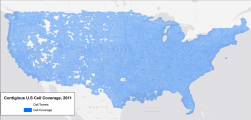
Recently, I was asked by a telecom company to produce a cell coverage base map where they could overlay their assets and customers; helping them to quantify their need for, and best locations of new cell tower construction within their service area.
 Cell Coverage in the United States. High resolution cell coverage data is envied by businesses all over the country. Unfortunately, providers and cell tower owners keep a tight leash on cell coverage information. Recently, I was asked by a telecom company to produce a cell coverage base map where they could overlay their assets and customers; helping them to quantify their need for, and best locations of new cell tower construction within their service area.
8 Comments
 Photo: Tammy Pelletier, WA State Dept of Ecology Water waves are formed by wind blowing over the surface of water. Wave height is dependent on: Wind speed, fetch (distance of water on which it is blowing), wind duration and water depth. In coastal bodies of water, wind waves, especially those associated with storms, can be unpredictable and pose hazards for recreational persons on the water in the short term and present long term erosional hazards to developed areas along the coast. Wemo is GIS tools which uses wind, depth and fetch data to map wave height potential in areas of contained water (i.e. lakes, bays, creeks). Wemo’s output can be used to assess shoreline erosion potential, and predict areas of dangerous wave heights during specific storm conditions.  Houses near Nags Head, NC Currently, the Outer Banks is witnessing significant rates of beach erosion, most of which is a function of sea level rise. In opposition to popular reporting, sea level rise and fall are a natural phenomenon which have been continuing for millennia. Currently we are in a period of sea level rise (Riggs and Ames 2003), the rate of which (most scientist agree) has been increased by human influenced global climate change (Gornitz et al. 1982). On the Outer Banks the effects of sea level rise are compounded by land subsidence from glacial isostatic adjustment. In fact, due to the local influence of land subsidence the Outer Banks could be experiencing a 60% greater rate of relative sea level rise in comparison to the national average of the United States (Cabanes et al. 2001). In March, 2011, I traveled to the Pea Island national wildlife refuge to terrestrial laser survey a section of overwashed dune in an attempt to establish a long term overwash monitoring site within the Cape Hatteras National Seashore. As I have detailed previously, overwash is an important aspect of barrier island landward migration and thus an important area of research along the Outer Banks, which is a barrier island. This is especially true if you also consider the amount state owned infrastructure and privately owned houses which are currently impacted or have the potential to be soon impacted by barrier island landward migration. 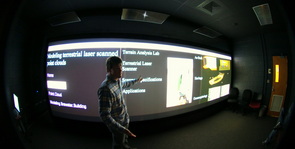 I placed first in the RENCI Visualization Challenge held at East Carolina University on March, 29, 2011. Each participant was challenged to make the best use of the Vis-wall during a ten minute presentation to an audience of faculty and students. The Vis-wall provides a unique environment for displaying content and consists of a rear projected display at the resolution of 4200 x 1400. My presentation introduced terrestrial laser scanning to the audience and provided them with a visualization of the Brewster building. I chose the Brewster building since the contest was being held within the building. This allowed the audience a better conceptual environment from which to understand terrestrial laser scanning technology, whereas if I had chosen any other laser scanned dataset, the audience may not have completely comprehended the abilities and methods of laser scanning. As part of the presentation I made an animation fly-through of the Brewster building model and point cloud data at a widescreen resolution appropriate to the resolution and aspect ratio of the Vis-wall. I have uploaded the video below, however in a resolution and proportion which is easier to view at standard aspect ratios found on most PC's and laptops. 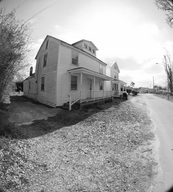 On 3/25/2011 I traveled to New Bern, North Carolina to terrestrial laser scan a historic house. The house, which was thought to have been built circa ~1900, is one of the few houses which survived a 1922 fire which devastated African American neighborhoods in New Bern causing over 2 million dollars in damage. Our terrestrial laser scan survey provided field measurements for modeling of the house and visualization back to its original state (vinyl siding and other alterations have been made over the years). This model and the laser scan survey will serve as the visual corner stone for the planned "trail of flames" website, which promotes a historic tour of burned areas from the 1922 fire in New Bern. 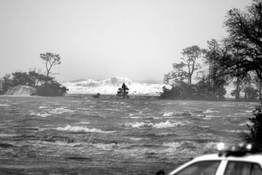 Storm surge during Hurricane Ivan (Photo: Chris Duval) The greatest potential for loss of life related a hurricane is from it's storm surge. For emergency managers, identifying what areas have the greatest vulnerability to storm surge is paramount for the mitigation of storm surge hazards. SLOSH is a GIS tool which the National Hurricane Center uses to estimate storm surge heights. In this example, I have estimated and mapped the number of potentially inundated census block groups during the event of a Category 3 hurricane landfall in Brunswick County, North Carolina. 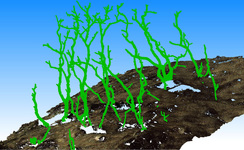 Segmented terrain (brown) and vegetation (green) A basic premise for all laser scanners (and remote sensing techniques in general) is that they remotely sense, capturing objects within their field of view. However, not everything which is located within a scanners field of view is useful, and in most instances extraneous data has a negative impact on the quality of the collected data. This is something that some leading laser scanning industry voices are beginning to notice as the next big hurtle for laser scanning to overcome, that is making a laser scanner only collect what you need, not everything within the scanners field of view. However, for now we must remove unwanted data and this requires filtering to identify, classify and separate the wanted and unwanted data. Although there are a myriad of filtering methods, the following paragraphs will detail three, relatively simple methods of filtering data from terrestrial laser scanner point clouds. 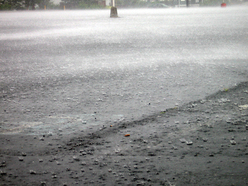 Rain on an impervious surface Impervious surfaces are (mainly) artificial structures (roads, parking lots, rooftops) which pave and seal the soil surface preventing or greatly reducing rainwater infiltration. Impervious surfaces have a negative impact on the quality of surface water and the ability of ground water to recharge (replenish itself). Therefore, monitoring the spatial pattern and percentage of impervious surfaces relative to non-impervious is an important aspect of water resources management. Moreover, as urban areas become more populated the a need exists to quickly and accurately assess the percentage of impervious surfaces to non-impervious within a watershed is of increasing importance, so that timely and correct land-use decisions can be made by local managers. The Impervious Surface Analysis Tool (ISAT) is an extension for ArcGIS which calculates the percentage of impervious surface area within a specified geographic area (i.e., watersheds, municipalities, subdivisions). ISAT results can also be used to predict how different management strategies could impact local water quality. For my Masters Thesis I am using Terrestrial Laser Scanned surveys from the GAP fire to investigate the effects of a recent wildfire on hydrologic and sedimentologic connectivity during the first significant rain event. Here I show examples of the captured terrain, hydrologic networks and their alteration, caused by the first significant rain event after the wildfire disturbance.
The surveys are both 1cm Digital Earth Models (DEMs). However, computationally the grids are larger than can be handled in ArcMap, therefore the DEM was re-sampled to a resolution of 2cm so that hydrologic networks could be calculated. Mean absolute errors for x, y, and z in both surveys were less than or equal to +/- 3mm. The procedures for hydrologic flow network delineation are based on the Deterministic 8 (D8) model for flow over a 2cm DEM. The D8 method produces a single flow direction towards the steepest slope of one of eight grid cells neighboring the initial center cell (O’Callahan and Mark, 1984; Tarboton, 2003). The D8 method was chosen for its simplicity and widespread use in hydrologic terrain analysis (Kiss, 2004). 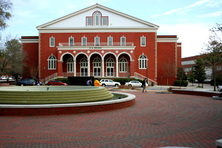 The Wright Building A long term goal of the Terrain Analysis Lab at ECU is to Terrestrial Laser Scan building or structures on East Carolina's campus that are both historically significant and recognizable landmarks, commonly associated with the image of East Carolina University's campus. Additionally, students enrolled in the Geography departments Terrestrial Laser Scanning graduate and undergraduate course were invited to assist, so that they could have hands on experience with the laser scanner in a real world environment. To satisfy these goals we chose to scan the Wright Building, located in the center of East Carolina University's campus. The Wright building was built in 1925, and along with the Cupola, is an iconic architectural structure on campus. |
|